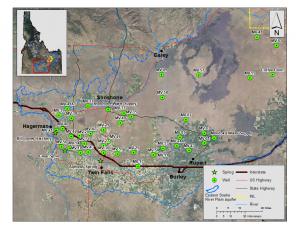DEQ’s Idaho National Laboratory Oversight Program (INL OP) maintains an environmental monitoring network on and around the INL to verify and supplement monitoring activities carried out by the US Department of Energy (DOE). Our staff take air, water, and terrestrial (soil and milk) samples and external radiation measurements to monitor the environmental impacts of the INL.
Staff also maintain a database of monitoring results covering over 20 years. This information allows staff to track radiation levels and contamination in the Eastern Snake River Plain Aquifer (ESRPA) and determine long-term trends.
Staff conduct monitoring around and within the INL boundaries and at upgradient, background, and distant locations for data comparisons.
This accordion will not appear on the screen
DEQ operates 11 air monitoring stations at and around the INL equipped with particulate air samplers, radioactive gas collectors, and water vapor collectors. Six of these air monitoring stations include precipitation collectors and three are community monitoring stations. We collect particulate air samples (filters) and radioactive iodine gas samples (charcoal cartridges) weekly to monitor short-term radiological conditions in the environment. We also collect atmospheric moisture to measure tritium concentrations present in the air and precipitation samples to monitor for tritium and gamma-emitting radionuclides that may be present in the environment.
Contaminants released through infiltration ponds, injections wells, buried waste, or spills at the INL have historically reached ground water. Our INL OP staff sample more than 100 water monitoring locations along the Eastern Snake River Plain Aquifer flowing beneath the INL and throughout the Magic Valley to detect for radioactive contaminants and monitor water quality. We sample wells, springs, streams, and selected wastewater sites. Most sites are sampled once a year, although Magic Valley locations are sampled on a triennial basis.
Radioactive substances can be deposited on soils and foliage where they can be taken up by plants and animals and can concentrate in the milk of cows and goats that graze on contaminated pastures or feed. When people eat contaminated meat, grains, milk, or vegetables the radioactive material can be absorbed in the body.
Following detailed standard operating procedures and using advanced equipment, INL OP staff monitor for radioactive material in the soil at and around the INL. These measurements identify the nuclides and concentrations of radioactivity in the soil and help determine if new sources of radioactivity are being deposited around the INL.
The INL OP conducts monthly milk sampling from sources in southern and southeastern Idaho designed to detect radioactive material such as radioactive iodine from nuclear reactors, which may have accumulated in milk produced by cows and goats.
DEQ compiles reports quarterly and annually to track monitoring results. Quarterly reports provide detailed data, while annual reports focus on long-term trends. Visit DEQ’s Public Records Request web page to request older reports.
Annual Reports
Quarterly Data Reports


